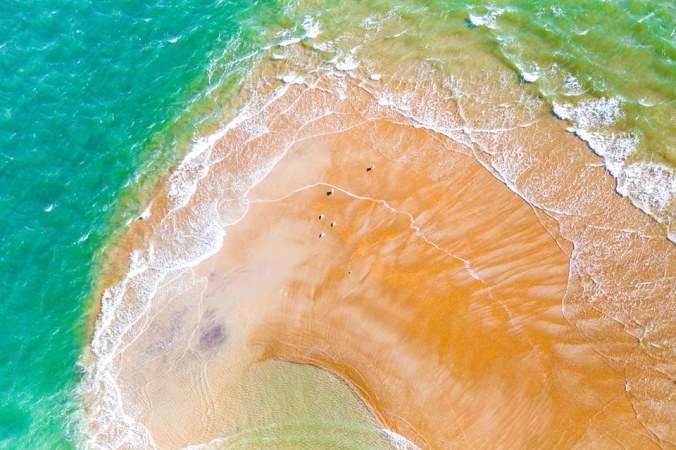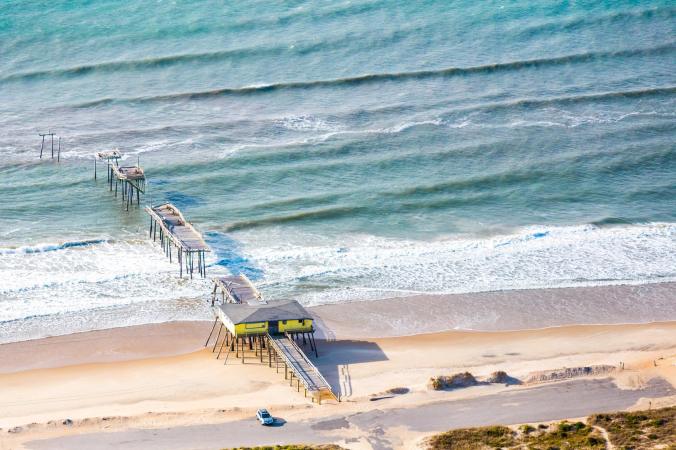Everyone has a story. More and more, those stories reveal the everyday impacts of climate change on local communities. They expose our vulnerabilities, weak spots in the socio-environmental interface, and our ability to rise above these challenges to create new opportunities for action. Rising, a multimedia exhibit of climate change in North Carolina, showcases these vulnerabilities and opportunities by combining oral histories with soaring aerial photography.

A photo from the exhibit shows birds standing on a shoal in the ever-changing Hatteras Inlet. Photo by Baxter Miller.
Inspired by a flight over the North Carolina coast, photographer Baxter Miller got together a group of community activists, local nonprofits, and academics to create a new tool for communicating climate change. Her idea was to pair dramatic photos of the shifting landscape with stories by the people experiencing those changes. The team received a community collaborative research grant from North Carolina Sea Grant and the William R. Kenan Jr. Institute for Engineering, Technology, and Science based at North Carolina State University to bring their vision to life.
Their first exhibit opened on February 16 at the Center for the Study of the American South at University of North Carolina at Chapel Hill. Rising directly addresses climate change, specifically the impacts that threaten coastal communities and their economies by elevating the voices of North Carolina’s coastal residents – from fishermen to lifelong residents. The exhibit tries to transcend current challenges in communicating climate change by relying on personal stories and vibrant art to create a shared, emotional connection among viewers.1 For those who can’t make it to Chapel Hill, the exhibit travels eastward to a coastal location in the state later this summer, and anyone can follow along online through Facebook and Instagram.

Visitors crowd around one of the photos during the exhibit’s opening reception in Chapel Hill. Photo courtesy of Rising.
Rising does what many other climate change projects fail to do: speak to people’s deeper humanity in ways that connect with our strongest values.2 Communicating climate change isn’t as simple as sharing the science; in fact, the more people know about climate change, the more they tend to become entrenched in their original positive or negative opinions.3 Rising overcomes this divide by showing climate change in a whole new light, calling upon personal stories and visual artifacts to show not tell. It uses stories to connect to community identities and relational values in a positive manner, emphasizing the personal relevance of climate change and potential responses.4 Miller, in a NC Sea Grant news release, sums up the goal of Rising by saying, “My hope is that it will provide an alternative lens through which to engage in conversation about whether my home region’s fate will be one of loss or continued resilience.”
While deeply place-based and personal, communities around the world could easily replicate the project. Drones, fast becoming an effective tool for many forms of science, have made aerial photography more cost-effective and anyone with a smartphone can start collecting stories from the people around them (for more guidance, check out these guides from The Smithsonian and StoryCorps). The impact of this type of project depends less on technology, though, and more on who gets involved. The stories will only be powerful if they represent real lived experiences and will only resonate with a wide audience if they represent diverse viewpoints. The organizers need to be established within the community or have an enhanced understanding of what stories might be available (and how) for the project to be successful. As a storyteller herself, Miller understood this hurdle and took careful measures in creating a team that could uncover the rich tapestry of life represented in the Rising exhibit.
How many people see the exhibit also enhances its overall impact. The traveling and social media aspects of Rising try to do this, but subsequent projects could increase visibility by having similar exhibits at schools, inviting important public figures/dignitaries, and/or by making it more interactive, such as collecting new stories at the exhibit or by using music. For many, a multimedia exhibit like Rising may represent the first time they see climate change as a human issue rather than a scientific question of data, models, and uncertainty.
“All good science is art,” reasoned English novelist John Fowles, followed closely by the idea underpinning this act of climate optimism: “And all good art is science.”

Photos showing both the beauty and fragility of the coast provide a gateway for talking about the impact of climate change on increasingly powerful storms. Photo by Baxter Miller.
References
-
- Corbett, J. B. and B. Clark. 2017. The arts and humanities in climate change engagement. Oxford Research Encyclopedia of Climate Science. Retrieved 18 Mar. 2018.
- Corner, A., Markowitz, E., and N. Pidgeon. 2014. Public engagement with climate change: the role of human values. WIREs Clim Change 5: 411-422.
- Kahan, D. M., Peters, E., Wittlin, M., Slovic, P., Ouellette, L. L., Braman, D., and G. Mandel. 2012. The polarizing impact of science literacy and numeracy on perceived climate change risks. Nature Climate Change 2: 732.
- O’Neill, S., and S. Nicholson-Cole. 2009. “Fear won’t do it”: Promoting positive engagement with climate change through visual and iconic representations. Science Communication 30(3):355-379.
Special thanks to Baxter Miller and the Rising team for permission to use their photos in this post!
This initiative sounds so cool! I love the collaboration of art and narrative in the context of the climate issue. Personal stories that are relatable or can invoke passion really help motivate people to take action in the face of injustices (whether caused by climate change or other sources). I would love to see this project expanded and think some interesting contributions could be generated right here in the greater Burlington area.
LikeLike
Addressing climate change from a direction that is not purely scientific is becoming more and more common and making the issue more assessable and engaging for a larger audience. I really like the idea of including and sharing personal stories in the project, as they are so often lost to the scientific jargon of climate science and policy. It is great that these communities are able to tell and share their stories and, as Heather said above, it would be great to see this sort of initiative expand to other areas facing different challenges.
LikeLike
Addressing climate change from a direction that is not purely scientific is becoming more and more common and making the issue more accessible and engaging for a larger audience. I really like the idea of including and sharing personal stories in the project, as they are so often lost to the scientific jargon of climate science and policy. It is great that these communities are able to tell and share their stories and, as Heather said above, it would be great to see this sort of initiative expand to other areas facing different challenges.
LikeLike
This is great to hear about! I just sent it to my friend who lives down there. The thought to get people to become engaged learning about climate change in a way that is attractive and not, for lack of better term, naggy. Topics that are complex and cover an issue that involves a very large area (in this case the entire world) require knowledge to understand. This knowledge, we have learned, is not intuitive. Which has led scientist to find ways to learn more about it. In order to have an impact on the issue everyone needs to be informed on factual evidence of what reality is being predicted in the next 30 years. Finally in order for people to actually learn the importance of making an impact they need to want to learn. Which is why a movie with high entertainment techniques is a great approach!
LikeLike
I really like this idea! I haven’t come across many art projects that integrate climate change. Maybe this is an effective way to convince climate deniers that global climate change isn’t a hoax- we talked today in class about tuning into our emotions to convince others that climate change is happening. I think images are very powerful in this way. An image can store lots of emotion and convey something that we may not be able to put into words. While factual evidence may be difficult to understand, photographs may grasp attention and state the most important point.
LikeLike
I couldn’t agree more with you on the power of storytelling in shifting the narrative and brining the issue “closer to home.” This idea of photo-exhibition and human dimension resonates with Tom Rogers’ lecture: instead of trying to “educate” people and further entrench their believes, make the narrative personal and relatable to their everyday lives.
I am curious to know the socio-demographic profile of people attending the exhibition. The enjoyment of art, in general, is an exclusive activity. I wonder if exhibitions like this one will attract a wider audience because of its methods and topic.
And just throwing a crazy idea out there: if that hasn’t been done already, we should find a photographer and do a similar exhibition here around Lake Champlain!
LikeLike